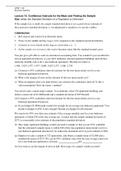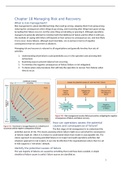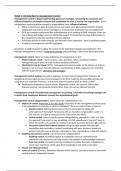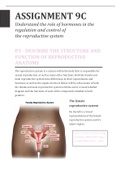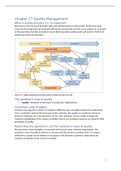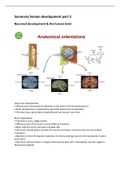Cell Biology
The cell theory
● The cell theory states that cells are the fundamental building blocks of all living organisms.
● The smallest organisms are unicellular: they consist of just one cell.
● Larger organisms are multicellular: they are composed of many cells.
Similar features in all cells:
1. Every living cell is surrounded by a membrane, which separates the cell contents from everything else
outside.
2. Cells contain genetic material which stores all of the instructions needed for the cell's activities.
3. Many of these activities are chemical reactions, catalysed by enzymes produced inside the cell.
4. Cells have their own energy release system that powers all of the cell's activities.
Exceptions to the cell theory
● Striated muscle: skeletal muscle is composed of muscle fibres, which are long fibres which can measure
300mm or more and are therefore much larger than regular cells. Each muscle fibre contains hundreds of
nuclei.
● Giant algae: these organisms are able to grow up to 200mm in length yet they’re unicellular and contain only
one nucleus. Due to their size, it is expected that they are composed of many cells.
● Aseptate Fungi: Fungi are made of thread like structures called hyphae divided by septa. However in aseptate
fungi these hyphae are not divided into sections, instead they are uninterrupted tube like structures that
contain many nuclei.
● Viruses: they are unable to keep in a stable state, nor do they grow or make their own energy. They do
replicate and adapt to their environment.
Unicellular organisms
Unicellular organisms carry out at least seven functions of life:
● Nutrition- obtaining food, to provide energy and the materials needed for growth.
● Metabolism- chemical reactions inside the cell, including cell respiration to release energy.
● Growth- an irreversible increase in size.
● Response- the ability to react to changes in the environment.
● Excretion- getting rid of waste products of metabolism.
● Homeostasis- keeping conditions inside the organism within tolerable limits.
● Reproduction- produce offspring either sexually or asexually.
Many unicellular organisms also have a method of movement, although some remain in a fixed position or drift in
water/air.
,Limitations on cell size:
Surface area to volume ratio is important in the limitation of cell size.
● In the cytoplasm of cells, large numbers of chemical reactions take place which are known as the metabolism
of the cell.
● The rate of these reactions (the metabolic rate of the cell) is proportional to the volume of the cell.
● For metabolism to continue, substances used in the reactions must be absorbed by the cell and waste
products must be removed.
● Substances moved in and out of cells through the plasma membrane at the surface of the cell.
- The rate at which substances cross this membrane depends on its surface area.
● The surface area to volume ratio of the cell is therefore very important- if the ratio is too small then the
substances will not enter the cell as quickly as they are required to and waste products will accumulate
because they are produced ,more rapidly than they can be excreted.
● Surface area to volume ratio is also important in relation to heat production and loss.
- If the ratio is too small then cells may overheat because the metabolism produces heat faster than it is
lost over the cell’s surface.
Multicellular organisms
Multicellular organisms have properties that emerge from the interaction of their cellular components
● Volvox aureus: a type of alga which lives together in a colony. Each colony consists of a ball made of a protein
gel, with 500 or more identical cells attached to its surface. The cells cooperate, but do not fuse to form a
single cell mass and so are not a single organism.
● Organisms consisting of a single mass of cells, fused together, are multicellular.
● Caenorhadbitus elegans: a multicellular worm.
- The adult body is about one mm long and it is made up of exactly
959 cells.
- It lives unseen in decomposing organic matter.
- It feeds on the bacteria that causes decomposition.
- It has a mouth, pharynx, intestine and anus.
- It is a hermaphrodite (male/female reproductive organs).
, - Almost ⅓ of its cells are neurons and are located at the front end of the worm in a structure that can
be seen as an animal's brain. Although the brain coordinates responses to the worms environment, it
doesn’t control how individual cells develop.
● In most multicellular organisms, the cells are usually cooperative groups as none of the cells act as a leader/
supervisor.
● Emergent properties- the characteristics of the whole organism, including the fact that it is alive.
● Emergent properties arise from the interaction of the component parts of a complex structure.
● In biology, we can carry out research by studying component parts, but we must remember that some bigger
things result from interactions between these components.
Cell differentiation in multicellular organisms
Specialized tissues can develop by cell differentiation in multicellular organisms
- In multicellular organisms, different cells perform different functions (the division of labour)
- Often a group of cells specialise in the same way to perform the same function- tissue.
- By becoming specialised, the cells in a tissue can carry out their role more efficiently than if they had many
different roles.
- They can develop the ideal structure, with the enzymes needed to carry out all the chemical reactions
associated with the function.
- The development of cells in different ways to carry out specific functions- differentiation.
Gene expression
Differentiation involves the expression of some genes and not others in the cell gnomes.
● There are many different cell types in a multicellular organism, but they all have the same set of genes.
● The 220 cell types in the human body have the same set of genes, despite large differences in their structure/
activities.
● Cells do not just have genes with the instructions that they need, they have genes needed to specialize in
every possible way.
● There are approx 25000 genes in the human genome, and these genes are all present in a body cell.
● When a gene is being used in a cell, we say it is being ‘expressed’.
- The gene is switched on and the information in it is used to make a protein or other gene product.
● The development of a cell involves switching on particular genes and expressing them, but not others.
● Cell differentiation happens because a different sequence of genes is expressed in different cell types.
● The control of gene expression is therefore the key to development.
Stem cells
The capacity of stem cells to divide and differentiate along different pathways is necessary in embryonic
development. It also makes stem cells suitable for therapeutic purposes.
● A new animal life when a sperm fertilises an egg cell, which produces a zygote, which is then made into an
embryo when the zygote divides. The embryo divides again to produce a four-cell embryo, then eight and so
on.
● At early stages in embryonic development the cells are capable of dividing many times to produce large
amounts of tissue.
● They are also super versatile and can differentiate along different pathways into any of the cell types found in
that particular animal.
The key properties of stem cells:
1. Stem cells can divide again and again to produce copious quantities of new cells. They are therefore used for
the growth of tissues or the replacement of cells that have been lost or damaged.
2. Stem cells are not fully differentiated. They can differentiate in different ways, to produce different cell types.
The cell theory
● The cell theory states that cells are the fundamental building blocks of all living organisms.
● The smallest organisms are unicellular: they consist of just one cell.
● Larger organisms are multicellular: they are composed of many cells.
Similar features in all cells:
1. Every living cell is surrounded by a membrane, which separates the cell contents from everything else
outside.
2. Cells contain genetic material which stores all of the instructions needed for the cell's activities.
3. Many of these activities are chemical reactions, catalysed by enzymes produced inside the cell.
4. Cells have their own energy release system that powers all of the cell's activities.
Exceptions to the cell theory
● Striated muscle: skeletal muscle is composed of muscle fibres, which are long fibres which can measure
300mm or more and are therefore much larger than regular cells. Each muscle fibre contains hundreds of
nuclei.
● Giant algae: these organisms are able to grow up to 200mm in length yet they’re unicellular and contain only
one nucleus. Due to their size, it is expected that they are composed of many cells.
● Aseptate Fungi: Fungi are made of thread like structures called hyphae divided by septa. However in aseptate
fungi these hyphae are not divided into sections, instead they are uninterrupted tube like structures that
contain many nuclei.
● Viruses: they are unable to keep in a stable state, nor do they grow or make their own energy. They do
replicate and adapt to their environment.
Unicellular organisms
Unicellular organisms carry out at least seven functions of life:
● Nutrition- obtaining food, to provide energy and the materials needed for growth.
● Metabolism- chemical reactions inside the cell, including cell respiration to release energy.
● Growth- an irreversible increase in size.
● Response- the ability to react to changes in the environment.
● Excretion- getting rid of waste products of metabolism.
● Homeostasis- keeping conditions inside the organism within tolerable limits.
● Reproduction- produce offspring either sexually or asexually.
Many unicellular organisms also have a method of movement, although some remain in a fixed position or drift in
water/air.
,Limitations on cell size:
Surface area to volume ratio is important in the limitation of cell size.
● In the cytoplasm of cells, large numbers of chemical reactions take place which are known as the metabolism
of the cell.
● The rate of these reactions (the metabolic rate of the cell) is proportional to the volume of the cell.
● For metabolism to continue, substances used in the reactions must be absorbed by the cell and waste
products must be removed.
● Substances moved in and out of cells through the plasma membrane at the surface of the cell.
- The rate at which substances cross this membrane depends on its surface area.
● The surface area to volume ratio of the cell is therefore very important- if the ratio is too small then the
substances will not enter the cell as quickly as they are required to and waste products will accumulate
because they are produced ,more rapidly than they can be excreted.
● Surface area to volume ratio is also important in relation to heat production and loss.
- If the ratio is too small then cells may overheat because the metabolism produces heat faster than it is
lost over the cell’s surface.
Multicellular organisms
Multicellular organisms have properties that emerge from the interaction of their cellular components
● Volvox aureus: a type of alga which lives together in a colony. Each colony consists of a ball made of a protein
gel, with 500 or more identical cells attached to its surface. The cells cooperate, but do not fuse to form a
single cell mass and so are not a single organism.
● Organisms consisting of a single mass of cells, fused together, are multicellular.
● Caenorhadbitus elegans: a multicellular worm.
- The adult body is about one mm long and it is made up of exactly
959 cells.
- It lives unseen in decomposing organic matter.
- It feeds on the bacteria that causes decomposition.
- It has a mouth, pharynx, intestine and anus.
- It is a hermaphrodite (male/female reproductive organs).
, - Almost ⅓ of its cells are neurons and are located at the front end of the worm in a structure that can
be seen as an animal's brain. Although the brain coordinates responses to the worms environment, it
doesn’t control how individual cells develop.
● In most multicellular organisms, the cells are usually cooperative groups as none of the cells act as a leader/
supervisor.
● Emergent properties- the characteristics of the whole organism, including the fact that it is alive.
● Emergent properties arise from the interaction of the component parts of a complex structure.
● In biology, we can carry out research by studying component parts, but we must remember that some bigger
things result from interactions between these components.
Cell differentiation in multicellular organisms
Specialized tissues can develop by cell differentiation in multicellular organisms
- In multicellular organisms, different cells perform different functions (the division of labour)
- Often a group of cells specialise in the same way to perform the same function- tissue.
- By becoming specialised, the cells in a tissue can carry out their role more efficiently than if they had many
different roles.
- They can develop the ideal structure, with the enzymes needed to carry out all the chemical reactions
associated with the function.
- The development of cells in different ways to carry out specific functions- differentiation.
Gene expression
Differentiation involves the expression of some genes and not others in the cell gnomes.
● There are many different cell types in a multicellular organism, but they all have the same set of genes.
● The 220 cell types in the human body have the same set of genes, despite large differences in their structure/
activities.
● Cells do not just have genes with the instructions that they need, they have genes needed to specialize in
every possible way.
● There are approx 25000 genes in the human genome, and these genes are all present in a body cell.
● When a gene is being used in a cell, we say it is being ‘expressed’.
- The gene is switched on and the information in it is used to make a protein or other gene product.
● The development of a cell involves switching on particular genes and expressing them, but not others.
● Cell differentiation happens because a different sequence of genes is expressed in different cell types.
● The control of gene expression is therefore the key to development.
Stem cells
The capacity of stem cells to divide and differentiate along different pathways is necessary in embryonic
development. It also makes stem cells suitable for therapeutic purposes.
● A new animal life when a sperm fertilises an egg cell, which produces a zygote, which is then made into an
embryo when the zygote divides. The embryo divides again to produce a four-cell embryo, then eight and so
on.
● At early stages in embryonic development the cells are capable of dividing many times to produce large
amounts of tissue.
● They are also super versatile and can differentiate along different pathways into any of the cell types found in
that particular animal.
The key properties of stem cells:
1. Stem cells can divide again and again to produce copious quantities of new cells. They are therefore used for
the growth of tissues or the replacement of cells that have been lost or damaged.
2. Stem cells are not fully differentiated. They can differentiate in different ways, to produce different cell types.


